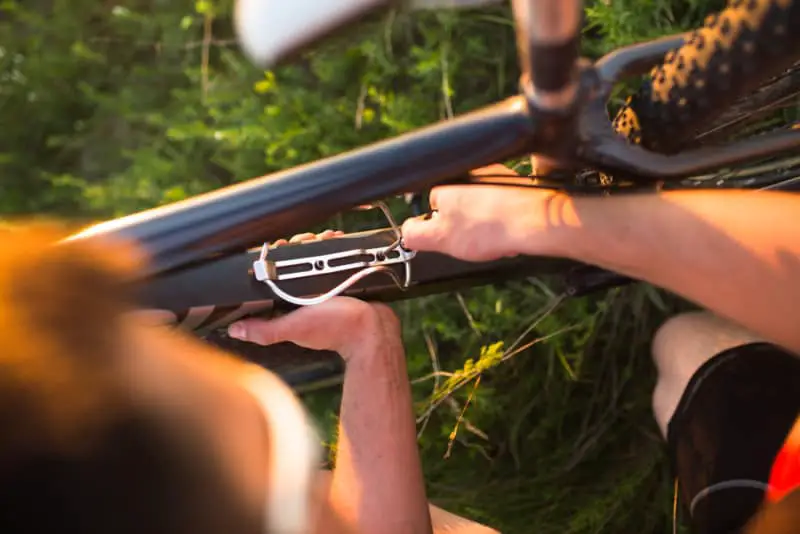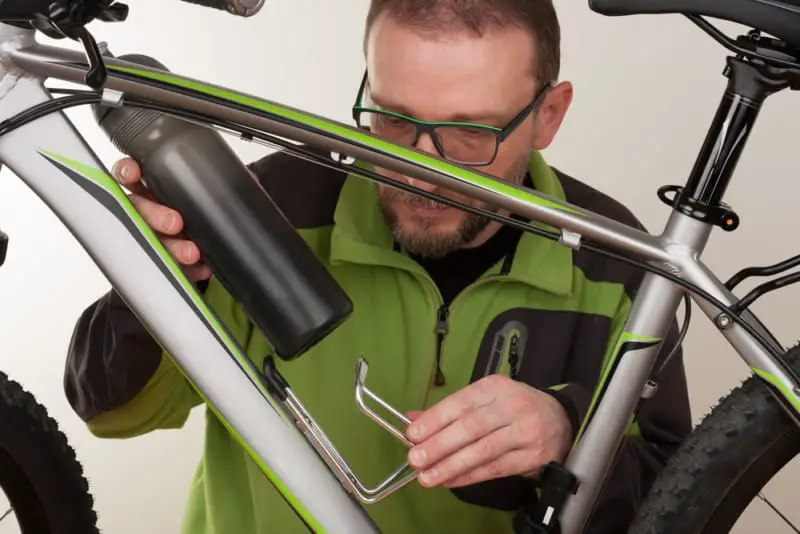Having a water bottled attached directly to your bike helps to keep you hydrated and happy on your rides. But, if your bike is missing a bottle cage (or if your old one broke) then you might be wondering if any bottle cage off the shelf will fit onto your specific bike.
In other words, are bike bottle cages universal?
Eyelet-mounted bottle cages are compatible with most modern bicycles. There is an industry standard size that makes most bottle cages interchangeable across bikes. However, some specialty bikes don’t have mounts and would require a bottle cage with an alternative attachment mechanism, like a quick release.
Because there are so many options when it comes to choosing the best cycling water bottle and cage, it can be confusing to pick one that’ll work for you. So, we’re going to dig deeper into bottle cage compatibility below, to help you sort things out.
Let’s get into it!
Are Water Bottle Cages Universal?
Nearly any bottle cage will be compatible with your bike, assuming your bike has built-in mounting eyelets called bottle cage “bosses”. These mounting eyelets are usually found on the down tube or the seat tube of the bike, and most consumer bicycles have them.
These eyelets are great because the size and spacing are standardized and will fit almost any bottle cage, assuming the bottle cage is built to be eyelet-mounted (which most, but not all, bottle cages are).

It’s worth briefly mentioning, that when bottle cages were invented, they were not all the same size. This created a problem because bikers would have water bottles that were too small for the cages resulting in bottles falling off during rides.
To solve this problem, bottle and cage manufacturers came together to create a standardized size for bottle cages so that bikers would always have a secure fit. A standard bottle cage can hold a water bottle up to 73mm in diameter and 127mm tall. Most bottle cages are equipped to hold bottles smaller than this size as well.
So, today we have the luxury of a standardized mounting system for bottle cages, which ALSO accommodates a (relatively) standardized bottle size.
With that said, there are a few different types of water bottle cages, which are worth understanding before choosing one.
Different Types of Water Bottle Cages
Bottle cages come in a variety of different materials like stainless alloy, plastic, or carbon fiber. Each material has its pros and cons depending on whether you are looking for adaptability, durability, style, or price. Keep reading to find out which material will be best for you.
Stainless Alloy
Stainless alloy cages have the simplest designs consisting of a singular loop. The simplicity of these cages creates a more secure fit, but they are heavier than their plastic and carbon fiber counterparts. Still, the heaviness is good for holding bottles of larger sizes for extra thirsty drinkers.
The secure fit of alloy mounts is well suited for rougher terrains. These are great if you are tough on your bike because the alloy can be bent back into its original shape if it’s been damaged.
Lastly, alloy bottle cages are going to be your cheapest option. If you are not very picky about your bottle cage and would like to save some money, consider purchasing an alloy cage.
Plastic & Carbon Fiber
Carbon fiber and plastic cages are often preferred for bikers that like to stand out because their designs are more extravagant, modern, and sleek.
These cages are designed to wrap around the water bottles, hugging them close, while giving riders quicker access to their bottles.
Because plastic and carbon filter materials are lighter than alloy, they are often less secure. You will have more ease of access to your bottle, but it is more likely to fall out. Therefore, these cages are best suited for more stable road conditions.
Additionally, plastic and carbon fiber materials have more give, or “spring” that is more forgiving of water bottles of different sizes. However, because the cage itself is lighter, it may only be able to support smaller water bottles leaving you with less water storage volume.
Do All Bikes Have Bottle Cage Mounts?

Unfortunately, some bikes are built without the mounts to attach bottle cages. This puts some bikers off and they choose not to purchase the offending bike as a result. But don’t worry! Even if a bike doesn’t come with a mount, there are other ways to attach your bottle cage.
Other Types of Bottle Cages
It can be frustrating having a bike that does not come with bottle mounts to attach your bottle cages. One of the easiest ways to solve this problem is to simply buy a bottle cage that is designed to attach to a non-traditional location on the bike. We’ll cover a few options here:
1. Quick-Release
These bottle cages are designed to attach to most locations on your bike frame and are easy to install and remove. Just like the name suggests, they were made specifically so that riders can remove them with ease whenever needed.
2. Handlebar Mounts
This is one of the most popular options because water bottles are easily accessible here. Because the bottle cage attaches directly to the handlebars, the water bottle will always be right in front of the rider, so they can easily grab it when they need a drink.
3. Seat Mount Bag
Seat mount bags are a popular option among bikers that become extra thirsty and like to carry extra water with them. These bags are like a saddle bag in that they hold traditional water bottles, but they are usually big enough to hold multiple bottles at a time.
One downside to these types of mounts is that they are located at the back of the seat, so riders must stretch behind them to get a drink. However, they are convenient for riders who like to carry extra devices on them such as their phone or bike tools.
DIY Bottle Mounts
If none of these options work for you, don’t worry. There are ways to attach traditional bottle mounts to your bike frame that work well. Here are a few options:
1. Hose Clamps
This is one of the easiest options because hose clamps can be found in any hardware store and attach to bikes very easily. Because of the material they are made from, they are an ideal option to hold the bottle cage to the bike more securely.
When using hose clamps, you can place your chosen bottle cage wherever you want on your bike. Close and tighten your clamp but be careful not to tighten it too much or it might break.
2. Straps
Straps are a super easy way to attach your bottle cage anywhere you like on your bike. Because they can easily be removed, you can change up your preferred location whenever you want. They are also one of the quickest ways to attach a bottle cage if you are strapped for time.
3. Zip Ties
Probably the most popular method of attaching bottle cages without mounts is to use zip ties. You simply thread the zip ties around the bottle cage and around the part of the bike you want to attach it to.
For best results, use more than one zip tie. Using multiple zip ties will keep your bottle cage more secure and prevent it from slipping.
Tape
Many bikers find that the easiest way to attach their bottle cages is by using electrical tape. Electrical tape is sturdy and strong. It will easily hold your bottle cage to the bike frame if you use a few layers.
What Size Bottle Fits in a Bike Bottle Cage?
Standard sized water bottles made specifically for bicycle bottle cages are generally 73mm in diameter and 127mm tall. Using a bottle of this size is the easiest way to ensure that your bottle will always fit in your bike’s bottle cage.
To allow a more secure fit on any size water bottle, many cages include inserts or collars made of rubber. More advanced cages even have bottle stoppers that can be adjusted to a variety of water bottle sizes.
Conclusion
Eyelet-mounted bottle cages should be compatible with any bicycle that has eyelet-mounts (or “bosses”) installed. If your bike does not have eyelet mounts available, then you’ll have to choose an alternative style of bottle cage (or at least an alternative method of attaching it to your bike frame).
